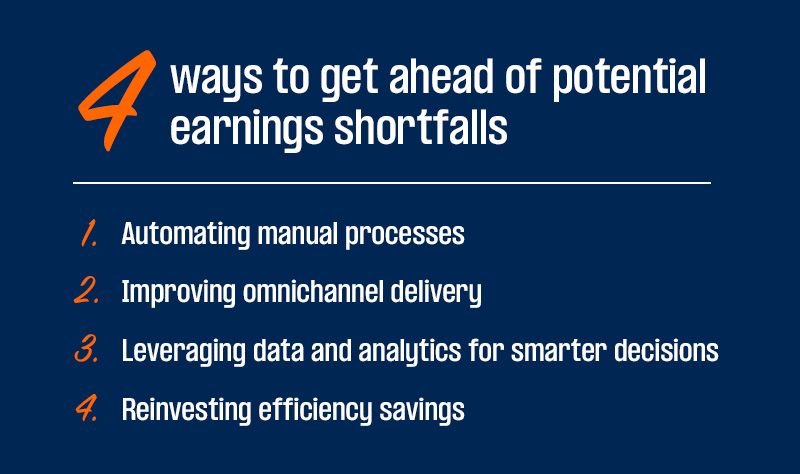Strategic Growth Playbook: 5 Priorities for Community Banks


Banks can turn today’s challenges into opportunities for smarter, more sustainable growth.
Community banks sit at a crossroads. They are being challenged to deliver the same seamless digital experiences as big banks and safeguard consumer trust against rising fraud, all while maintaining profitability and prioritizing strategic growth.
But what smaller banks lack in scale, they make up for in mission: deep community roots, agility to adapt quickly and personal relationships that foster loyalty. To thrive in this environment, banking leaders must align their mission with strategies that drive sustainable growth.
Growth isn’t about chasing scale for its own sake – it’s about sharpening focus, building resilience and finding smarter ways to deliver on what customers and communities value most. Leaders ready to be more strategic and less reactive can focus on five priorities to invest in the future of relationship-driven banking.
Priority 1: Increase Operational Efficiency
Consumers are concerned about the financial future, more than half of survey respondents describing the U.S. economy as “uncertain” or “struggling.” As a result, they are approaching their own financial decisions with caution. Even the most loyal customers may shop around for the best rates when looking for a loan or high-yield savings account.
So, how do executives get ahead of potential earnings shortfalls? It’s not just about cutting spending. As counterintuitive as it may seem, up-front investments can produce long-term savings by creating capacity for growth. Here’s how:
- Automating manual processes: Digitizing loan decisioning and processing can cut approval and underwriting times from weeks to days. This frees staff to focus on more complex tasks and higher-value advisory work.
- Improving omnichannel delivery: Customers should be able to start a mortgage application online, complete it in a branch and track their status in the mobile app without reentering information. Ensuring that customers have the same experience across locations and devices will build lasting loyalty and repeat business.
- Leveraging data and analytics for smarter decisions: With information at their fingertips, banks can feel empowered to determine the right course of action, from using transaction data to forecast liquidity needs to identifying customers at risk of attrition, and take steps to strengthen relationships.
- Reinvesting efficiency savings: When banks do achieve operational savings, they can be redirected into investments that improve customer experience and grow loyalty, like expanded self-service tools or financial education programs.

Priority 2: Build Revenue Diversity
In times of economic uncertainty, reliance on traditional revenue streams can leave banks vulnerable to market volatility and competitive pressures. Three in 4 bank CEOs say that they are prioritizing core deposit growth to offset potential losses or low earnings in other areas, according to a recent survey by the American Bankers Association.
Banks looking to strengthen their balance sheet should leverage data to explore new opportunities for revenue growth. Identifying untapped or underserved markets – say, microbusinesses or gig workers – and reaching them with tailored checking products or flexible credit options can stimulate growth. Banks can also target small and medium-sized businesses by introducing modernized payments and merchant services to capture point-of-sale and e-commerce transactions. And offering rewards cards to small businesses and consumers can deepen wallet share and drive valuable interchange income.
Priority 3: Embrace a Modern Core
Legacy cores are holding banks back – and not just in terms of digital banking innovation. They are barriers to efficiency and security, too. Outdated infrastructure prevents institutions from streamlining operational costs, reduces opportunities for offering better and more profitable products and services, and puts bank and customer data at risk.
Upgrading core technology is an investment in growth, profitability and long-term cost efficiency. A modernized core can replace multiple redundant legacy systems, simplifying infrastructure and cutting overhead costs for long-term savings. What’s more, it can support strategic growth at scale. For example, advanced cores give banks the flexibility and agility to launch new products in weeks instead of months or introduce enhancements to enable seamless, real-time omnichannel experiences. And banks that want to expand into new geographic regions can evolve with a platform that accommodates significant growth of branches and customer accounts.
Priority 4: Secure Data and Prevent Fraud
Cybercriminals count on smaller banks to make smaller investments in security. And they’re increasingly targeting community and regional banks, putting these institutions at risk of significant damage to their bottom line, not to mention customer trust and reputation.
Banks can invest strategically in fraud detection and prevention to shore up defenses and reassure customers that their deposits and data are safe.
- Investing in AI-powered detection: Banks can deploy monitoring tools that flag anomalies, like an unusual overseas transfer request from a local client’s account, providing real-time alerts and preventing fraud attempts before they start.
- Strengthening security infrastructure: Implement multi-factor authentication – which can deter attacks – and educate your customers on safe password usage. Offering quarterly cybersecurity workshops or producing educational content can help your business and consumer clients understand threats like phishing and ransomware, protecting them and building trust in your organization.
- Enhancing compliance: Automating reporting reduces errors, reduces manual workloads and ensures that regulators receive accurate, timely data during audits or inquiries.
Priority 5: Acquire New Customers
For a community bank, growth doesn’t always mean opening more branches or expanding to new geographic markets. This year, according to the aforementioned ABA survey, many CEOs say they are focusing on organic expansion within their existing markets by focusing investments.
For community banks, this can mean expanding into new segments, such as offering treasury and merchant services to local nonprofits or small businesses to deepen institutional relationships. And internal and industry data can guide banks to analyze demographic shifts and guide targeted product development accordingly. For example, they may find that younger customers in the community are moving away from traditional banks in favor of digital-first competitors, prompting investments in digital services.
More than 20% of applications come in after normal bank hours according to Fiserv internal data – and digital-first competitors are capturing clientele simply by being more available and responsive. But community banks can be there around the clock, too. Automated credit scoring can simplify loan decisioning, ensuring a person applying for an auto loan or credit card receives an immediate decision, rather than waiting days. And instant onboarding means a new customer can open a checking account online, receive immediate verification and begin transacting whether they apply in the middle of the day or night.
Building Resilience with a Community-First Focus
Community banks need not sacrifice their local-first values to spur growth. In fact, their focus on the needs of local customers and businesses sets them apart from larger competitors. The ability to adapt quickly while maintaining a community-centric focus will define which institutions thrive in the years ahead – and which ones fall behind. By focusing strategically on growth that supports existing and new customers, banking leaders can build resilience while staying true to their mission.